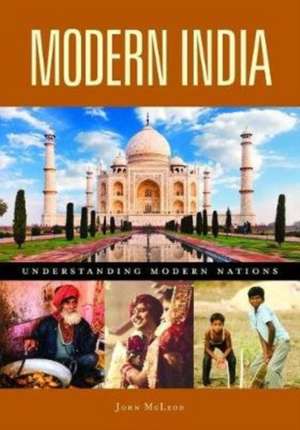Modern India: Understanding Modern Nations
Autor John McLeoden Limba Engleză Hardback – 14 noi 2019 – vârsta până la 17 ani
Preț: 429.41 lei
Preț vechi: 738.10 lei
-42% Nou
Puncte Express: 644
Preț estimativ în valută:
82.17€ • 87.87$ • 68.51£
82.17€ • 87.87$ • 68.51£
Carte tipărită la comandă
Livrare economică 18 aprilie-02 mai
Preluare comenzi: 021 569.72.76
Specificații
ISBN-13: 9781440852886
ISBN-10: 144085288X
Pagini: 464
Ilustrații: 34 bw illus
Dimensiuni: 178 x 254 x 29 mm
Greutate: 1.16 kg
Editura: Bloomsbury Publishing
Colecția ABC-CLIO
Seria Understanding Modern Nations
Locul publicării:New York, United States
ISBN-10: 144085288X
Pagini: 464
Ilustrații: 34 bw illus
Dimensiuni: 178 x 254 x 29 mm
Greutate: 1.16 kg
Editura: Bloomsbury Publishing
Colecția ABC-CLIO
Seria Understanding Modern Nations
Locul publicării:New York, United States
Caracteristici
Includes "Day in the Life" features that portray specific daily activities of various people in the country, from high school students to working class people to professionals, providing readers with insight into daily life in the country
Notă biografică
John McLeod, PhD, is professor of history at the University of Louisville, Louisville, KY. He is the author of Greenwood's The History of India, Second Edition.
Cuprins
Series ForewordNote on TransliterationAbbreviationsPrefaceIntroductionChapter 1: GeographyOverviewClimateDeccanDisputed TerritoriesHimalayasIndian OceanIndo-Gangetic PlainIslandsMajor CitiesNatural ResourcesPollution and the EnvironmentPopulationRiversStates and Union TerritoriesThar DesertTransportationWater ConservationChapter 2: HistoryOverviewTimelineBabur (1483â?"1530) and the Mughal Empire (1526â?"1857)Chandragupta (ruled c. 325/321â?"297 BCE) and the Mauryan Dynasty (c. 325/321â?"185 BCE)Chandra Gupta I (ruled c. 320â?"335), the Gupta Dynasty (c. 320â?"550), and Harshavardhana (ruled 606â?"647)Gandhi, Indira Priyadarshini (née Nehru) (1917â?"1984)Gandhi, Mohandas Karamchand (Mahatma, â?oGreat Soulâ?) (1869â?"1948)Gandhi, Rajiv (1944â?"1991)Harappans and AryansIltutmish (ruled 1210â?"1236) and the Delhi Sultanate (1210â?"1526 and 1540â?"1555)Jinnah, Mohammad Ali (Qaid-e-Azam, â?oGreat Leaderâ?) (c. 1876â?"1948)Lakshmibai, Rani (c. 1827 or 1835â?"1858)Nehru, Jawaharlal (1889â?"1964)Rao, Pamulaparti Venkata Narasimha (1921â?"2004)Shivaji (1630â?"1680) and the Maratha Empire (1674â?"1818)Singh, Manmohan (1932â?")Chapter 3: Government and PoliticsOverviewArmed ForcesBharatiya Janata Party (BJP)Communist Parties in IndiaConstitutionCorruptionElectionsForeign RelationsGandhi, Sonia (née Edvige Antonia Albina Mà ino) (1946â?")Indian National CongressJanata Party and Janata DalLegal System and Law EnforcementModi, Narendra Damodardas (1950â?")ParliamentPrime Minister and Council of MinistersRegional PartiesState and Local GovernmentChapter 4: EconomyOverviewAgricultureEnergy IndustryFinancial InstitutionsForeign InvestmentForeign TradeLand PolicyLiberalizationManufacturingMigrant LaborersNehruvian EconomyPirating and Copyright IssuesPublic Sector EnterprisesReserve and Foreign DebtRupee and Currency ExchangeSen, Amartya Kumar (1933â?")Service IndustryStock ExchangesTrade Union and Labor MovementWorkplace SafetyWorld Trade Organization and Group of TwentyChapter 5: Religion and ThoughtOverviewBuddhismChristianity in IndiaFolk Religions in IndiaHinduismIslam in IndiaJainismReligious ReformismReligious Violence in IndiaSikhismZoroastrianism in IndiaChapter 6: Social Classes and EthnicityOverviewAging PopulationCaste SystemDalitsEthnic GroupsHealth CareMiddle ClassOther Backward ClassesPoverty and Social WelfareRetirementTribalsUrbanizationChapter 7: Gender, Marriage, and SexualityOverviewDomestic ViolenceDowryEducationEmploymentFamily Life, Marriage, and SexualityHealthLGBT IssuesMarriageSex-Selective AbortionSex TradeChapter 8: EducationOverviewElementary and Secondary EducationIndian Institutes of ManagementIndian Institutes of TechnologyInternational Students and Foreign Exchange ProgramsPostsecondary EducationRaman, Chandrasekhara Venkata (1888â?"1970)Religious EducationChapter 9: LanguageOverviewEnglishHindiSanskritScheduled LanguagesScriptsChapter 10: EtiquetteOverviewEtiquette in Ancient TextsGreetings and IntroductionsMarriagePurity, Pollution, and MealsVisiting and HospitalityChapter 11: Literature and DramaOverviewBardic Literature in IndiaEnglish Literature in IndiaHindi LiteratureIndian DramaJnanpith Award and Sahitya Akademi AwardLiterature in Indian Regional LanguagesMahabharata and RamayanaPersian Literature in IndiaSanskrit LiteratureTagore, Rabindranath (1861â?"1941)Vedic LiteratureChapter 12: Art and ArchitectureOverviewChandigarh and Planned CitiesColonial Architecture in IndiaHarappan Art and ArchitectureHindu Temple ArchitectureIndo-Islamic ArchitectureMughal and Rajput PaintingNew DelhiChapter 13: Music and DanceOverviewClassical DanceClassical MusicContemporary and Bollywood DanceDevotional MusicFolk Music and DancesMusical InstrumentsPopular MusicChapter 14: FoodOverviewChristian FoodwaysCooking Techniques and EquipmentDiet and HealthEating OutFeasts, Fasts, and FestivalsFood and IngredientsHindu FoodwaysJain FoodwaysMealsMuslim FoodwaysParsi FoodwaysSikh FoodwaysSpicesTribal (Adivasi) FoodwaysChapter 15: Leisure and SportsOverviewAlcohol and NarcoticsChildren's GamesCricketFootball (Soccer)HockeyNightlifeVacationsWrestlingChapter 16: Media and Popular CultureOverviewAlternative and Community MediaBollywood and the Hindi Film IndustryCinema AudiencesThe Internet and Social MediaNews Regulation and CensorshipPopular Music CulturesReligion, Politics, and Visual CultureAppendix A: A Day in the LifeA Day in the Life of a FarmerA Day in the Life of a Hotel TraineeA Day in the Life of a Leather WorkerA Day in the Life of a StudentA Day in the Life of a WidowAppendix C: Facts and FiguresAppendix D: HolidaysSelected BibliographyIndex
Recenzii
Useful for both undergraduates and general readers interested in learning more about modern India.
Recommended. All readership levels.
Recommended. All readership levels.











